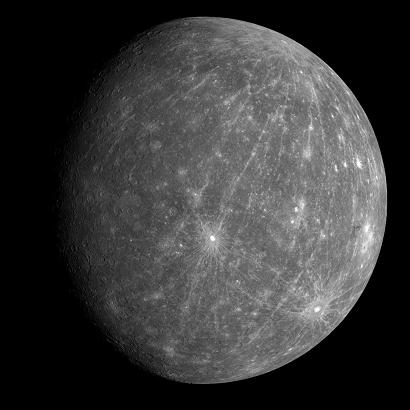The Mercury Messenger spacecraft photographed a young crater and a system of 'rays' emanating from it for the first time, together with another 30% of the surface of the planet Hema that has not yet been photographed up close

On Monday this week, the Mercury Messenger spacecraft passed by the planet Hama and photographed extensive areas that had not been photographed before. The first of over 1,200 high-resolution images has begun streaming down to Earth.
"The MESSENGER team is particularly pleased with the excellent performance of the spacecraft and its systems," said the spacecraft's principal investigator, Sean Solomon of the Carnegie Institution in Washington. "We are now on the right track to inject the spacecraft into orbit around the planet Hema, and all our instruments returned the data as planned."
The spectacular image - one of the first to be broadcast - was taken by Mercury Messenger's wide-angle camera, about 90 minutes after the closest point, when the spacecraft was about 27 km from Mercury.
The most amazing feature of the new area is a large pattern of rays streaking down from the northern regions of the planet. This system of rays appears to be coming out of a relatively young crater that was previously only observed through radar images from Earth, as photographed for the first time from a spacecraft located near the planet. This photograph of the planet is also unique compared to anything seen by Messenger during its first approach flyby in January 2008.
In the 10s, when Mariner 20 flew past Mercury three times, it photographed less than half of the planet. Massengkar's first flyby in January of this year covered another 6% of the planet's surface. This week, on October 30, MESSENGER was able to complete its second flyby of the planet Hema and revealed an additional XNUMX% of its surface that had not yet been observed up close. "When this data is digested and compared, we will have a global perspective of the planet Hema for the first time" comments Solomon. "Data from the approach flight continues to flow to Earth, including close-up high-resolution images of previously unseen areas.

4 תגובות
Numerology Astrology Kabbalah Zeus Venus and Jupiter alone hand in hand in the sky but only in the sky
Good day, Shabbat Shalom
fun to watch
many thanks!
For sale from a contractor
A spaceship in a good location
with lots of sun
And an amazing view
Here are more pictures and this time in really high resolution -
1.
http://messenger.jhuapl.edu/gallery/sciencePhotos/search.php?form_keywords=60
2.
http://messenger.jhuapl.edu/gallery/sciencePhotos/search.php?form_keywords=60&txtonly=&search_type=&form_date=&fromyear=&frommonth=&fromdate=&toyear=&tomonth=&todate=&search_cat=&page=2
3.
http://messenger.jhuapl.edu/gallery/sciencePhotos/view.php?gallery_id=2&page=3&bytopic=&bydate=
(and note that there are many more pages later....)